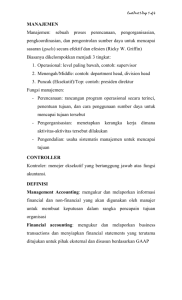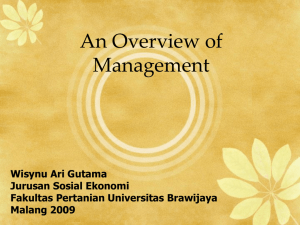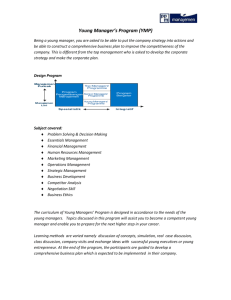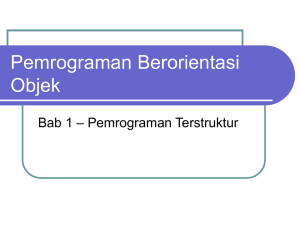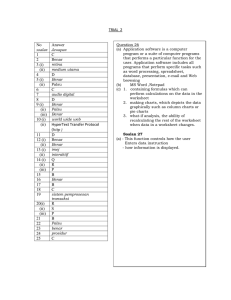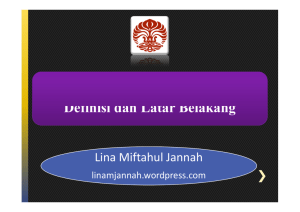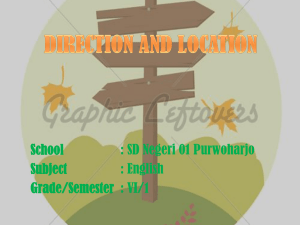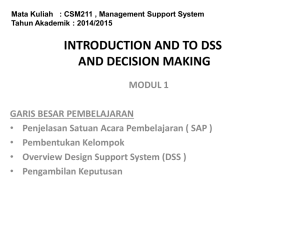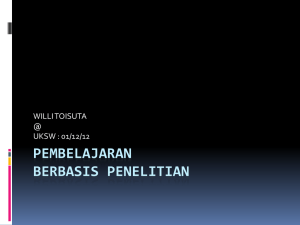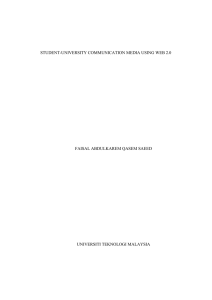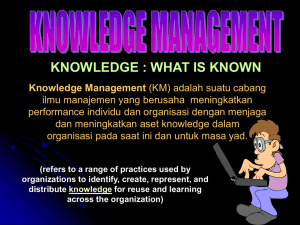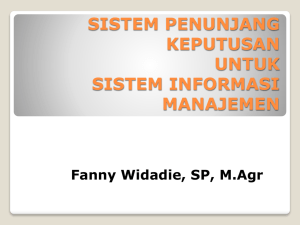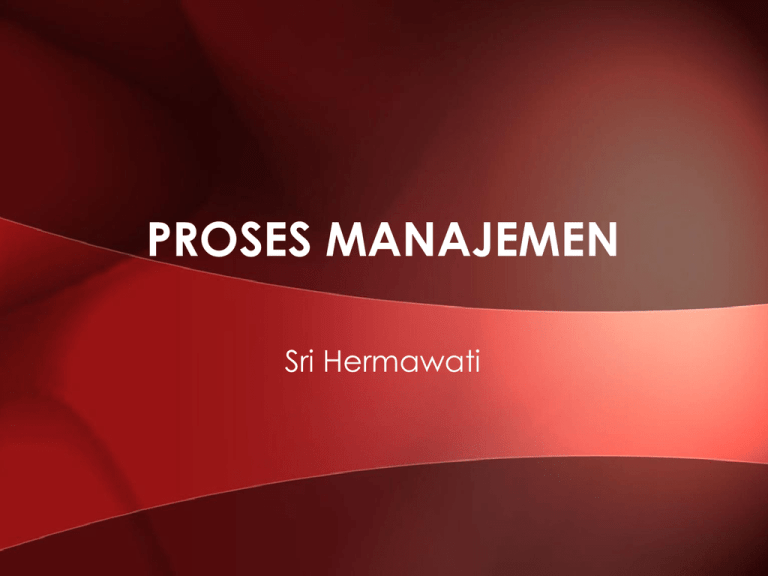
PROSES MANAJEMEN
Sri Hermawati
Siapa yang membutuhkan manajemen ?
Perusahaan (bisnis)
Semua tipe organisasi
Semua tipe kegiatan
Mengapa manajemen dibutuhkan ?
1.
Untuk mencapai tujuan organisasi
2.
Untuk menjaga keseimbangan di antara
tujuan-tujuan yang saling bertentangan
3.
Untuk mencapai efisiensi dan efektifitas
WHAT IS MANAGEMENT?
• Management
– The planning, organizing, leading, and
controlling of human and other resources to
achieve organizational goals effectively and
efficiently.
• Managers
– The people responsible for supervising the use of
an organization’s resources to meet its goals.
• Resources are organizational assets
– People Skills
Knowledge Information
– Raw materials Machinery Financial capital
1–3
MANAGEMENT IS…
Getting work
done through
others
Efficiency
Effectiveness
4
EFFICIENCY AND EFFECTIVENESS
• Efficiency (Focus on Process/means)
– Getting work done with a minimum of
effort, expense, or waste
– Doings things right—most output for
least input
• Effectiveness (Focus on ends)
– Accomplishing tasks that help fulfill
organizational objectives
– Doing the right things (you do your job
well)
5
EFFICIENCY, EFFECTIVENESS, AND PERFORMANCE IN AN
ORGANIZATION
Peter Drucker mengatakan bahwa:
• Efektifitas
adalah
melakukan
pekerjaan yang benar (doing the
right things)
• Efisiensi
adalah
melakukan
pekerjaan
dengan
benar
(doing things right)
FUNCTIONS OF MANAGEMENT
• Planning,
• Organizing,
• Staffing,
• Leading,
• Controlling
PLANNING
• Identifying and selecting appropriate
goals and courses of action for an
organization.
– The planning function determines how
effective and efficient the organization is and
determines the strategy of the organization.
• Three Steps in the Planning Process:
– Deciding which goals to pursue.
– Deciding what courses of action to adopt.
– Deciding how to allocate resources.
© Copyright 2004 McGraw-Hill. All rights reserved .
1–9
ORGANIZING
• Structuring working relationships in a way
that allows organizational members to
work together to achieve organizational
goals.
• Organizational Structure
– A formal system of task and reporting
relationships that coordinates and motivates
organizational members.
– Creating organizational structure:
• Grouping employees into departments according to the
tasks performed.
• Laying out lines of authority and responsibility for
organizational members.
1–10
FUNCTIONS OF MANAGEMENT
(STAFFING)
• Staffing is a process of
– Getting right people, for right job, at right
time.
• People are asset for an organisation.
– Attracting people to the organization.
– Creating good working conditions
– Specifying job responsibilities and training.
– Grouping jobs into work units and
development.
FUNCTIONS OF MANAGEMENT
(LEADING)
• Leading is a process of
– Inspiring, motivating or directing people so that
they will contribute to organizational objective.
• Leading involves motivation, leadership
theories and communication.
• An important role of a manager is to
motivate the people working on a
project.
CONTROLLING
• Evaluating how well an organization is
achieving its goals and taking action to
maintain or improve performance.
– Monitoring individuals, departments, and the
organization to determine if desired
performance standards have been reached.
– Taking action to increase performance as
required.
– The outcome of control is the ability to
measure performance accurately and to
regulate the organization for efficiency and
effectiveness.
1–13
TINGKATAN MANAJER
• Top Managers.
• Middle Managers.
• First-Line Managers.
RESPONSIBILITIES OF TOP MANAGERS
Creating a context for change
Developing commitment
and ownership in employees
Creating a positive organizational
culture through language and action
Monitoring their business environments
15
RESPONSIBILITIES OF MIDDLE
MANAGERS
Plan and allocate resources to meet objectives
Coordinate and link groups,
departments, and divisions
Monitor and manage the performance
of subunits and managers who report to them
Implement changes or strategies
generated by top managers
16
RESPONSIBILITIES OF FIRST-LINE
MANAGERS
Manage the performance of
entry-level employees
Encourage, monitor, and reward
the performance of workers
Teach entry-level employees how to do their jobs
Make detailed schedules and operating plans
17
RELATIVE AMOUNT OF TIME THAT MANAGERS
SPEND ON THE FOUR MANAGERIAL FUNCTIONS
1–18
Figure
1.4
SKILL TYPES NEEDED BY MANAGERIAL LEVEL
1–19
MANAGEMENT SKILLS
(R. L. KATZ)
Top Managers
Conceptual Skills
Middle Managers
Human Skills
First line Managers
Technical Skills
20
MANAGEMENT SKILLS
• Technical skills
– Knowledge and proficiency in a specific
field.
– Resource Management (Different)
• Human skills
– Networking within and outside the
organization.
– Working in teams.
– Monitoring and coaching
– Understanding of cultural differences
21
MANAGEMENT SKILLS
• Conceptual skills
– Ability to identify opportunities
– Recognize problem areas and its
solutions
– Understating of business model
– Ability to transform ideas into words and
actions.
22
SUMBER
• gcuf.edu.pk/online_lectures/1323201621.
ppt
• John, Garet R. and jenneifer M, George.
2004. ESSENTIAL OF CONTEMPORARY
MANAEMENT, third ed, McGraww HillIrwin.

